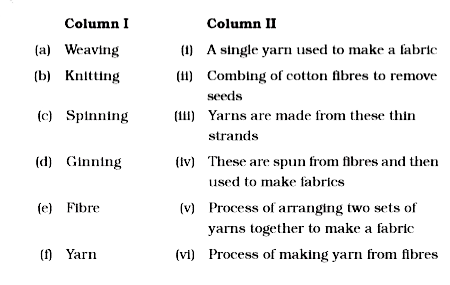Match the reactions given in Column I with the statements given in Column II.

(a) — (iv), (b) — (iii), (c) — (i), (d) - (ii)
Topper's Solved these Questions
- ORGANIC COMPOUNDS CONTAINING NITROGEN Book:MODERN PUBLICATIONChapter:ORGANIC COMPOUNDS CONTAINING NITROGEN Exercise:NCERT FILE ASSERTION AND REASON TYPE QUESTIONS
Explore 7 Videos
- ORGANIC COMPOUNDS CONTAINING NITROGEN Book:MODERN PUBLICATIONChapter:ORGANIC COMPOUNDS CONTAINING NITROGEN Exercise:QUICK MEMORY TEST A. SAY TRUE OR FALSE
Explore 10 Videos
- ORGANIC COMPOUNDS CONTAINING NITROGEN Book:MODERN PUBLICATIONChapter:ORGANIC COMPOUNDS CONTAINING NITROGEN Exercise:NCERT FILE SHORT ANSWER TYPE QUESTIONS
Explore 28 Videos
- HALOALKANES AND HALOARENESBook:MODERN PUBLICATIONChapter:HALOALKANES AND HALOARENESExercise:UNIT PRACTICE TEST
Explore 11 Videos
- POLYMERSBook:MODERN PUBLICATIONChapter:POLYMERSExercise:Competition file (OBJECTIVE TYPE QUESTIONS) (C. MULTIPLE CHOICE QUESTIONS)(Integer Type Questions)
Explore 6 Videos
Similar Questions
Match the reactions given in Column I with the names given in Column II.

View SolutionMatch the reactions given in Column I with the names given in Column II.

View SolutionMatch the reactions given in Column I with the names given in Column II.

View SolutionMatch the terms given in Column I with the statements given in Column II

View SolutionMatch the reactions given in Column I with the names givn in Column II.

View SolutionMatch the reactions given in Column I with the suitable reagents given in Column II.
 .
.
View SolutionMatch the reactions given in Column I with the suitable reagents given in Column II.

View SolutionMatch the reactions given in column I with the names given in column II.
 .
.
View SolutionMatch the reactions given in Column I with the suitable reagents given in Column II.

View SolutionMatch the defects given in Column I with the statements in given Column II.

View Solution

